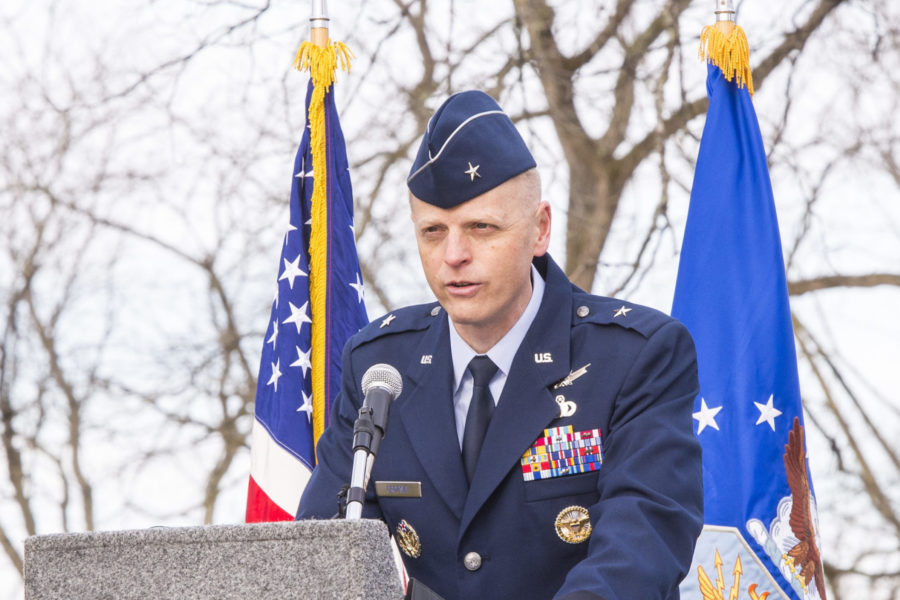A little more than two months into his new job as the Air Force’s program executive officer overseeing acquisition for the service’s ambitious Advanced Battle Management System (ABMS), Brig. Gen. Luke C.G. Cropsey has identified three integration issues he’ll have to help solve—but is still assessing which of the many efforts in his new portfolio he wants to pursue first.
Speaking with reporters during a roundtable Nov. 29, Cropsey defined his two goals as separate but related: getting to “survivable” command and control while deploying C2 capabilities that “support a combatant commander’s scheme of maneuver.”
It’s all part of a broader effort across the Pentagon to create joint all-domain command and control, or JADC2—a network of networks that connects sensors, shooters, and battle managers across the globe, a so-called “Internet of Military Things.”
ABMS is the Air Force’s contribution to JADC2, but for several years now, the department has lacked a centralized authority to coordinate and integrate efforts. Upon taking office, Air Force Secretary Frank Kendall criticized the program for an over-emphasis on experimentation, saying its focus needed to be on delivering operational capabilities.
Kendall pushed that effort further with one of his operational imperatives, calling for “operationally optimized” ABMS. And in September, he installed Cropsey as the authority responsible for coordinating efforts across command, control, communications, and battle management (C3BM).
Given the sprawling, ambitious nature of both ABMS and JADC2, Cropsey’s job is “the hardest acquisition job I’ve ever given anybody,” Kendall said at the time.
It also requires Cropsey to interface with other services, program executive officers, and researchers and developers as they all try to integrate their efforts into a cohesive whole.
Such integration faces three challenges, Cropsey said. The first involves ensuring that all the hardware and software the Air Force uses across its weapon systems can connect.
“The technical integration challenge that we have is how do we combine all those different parts and pieces across that whole kill chain—across those find, fix, track, target, engage and assessment activities—so that we can make the effects that we need to happen actually a reality,” Cropsey said.
The second is about building networks and infrastructure designed to integrate with each other and pass data, while still being secure.
And the final challenge might be the broadest—finding a way to integrate requirements and capabilities within a process from a different era.
“If you think about the way that we plan, we do requirements, we budget, we do acquisition programs, they’re all kind of weapons systems-centric in the way that we think about and execute them,” Cropsey said. “This problem is fundamentally different in the sense that we’re trying to do a horizontal integration problem across all of those individual platforms, in order to create [connection] across the battle space.”
That last part could prove especially tricky as Cropsey’s job will involve working with many other PEOs in charge of their own programs.
“On the one hand, every single PEO is a direct report to the [service acquisition executive], and it’s that way for a reason. So the first thing I’ll say is I’m absolutely not going to get in between one PEO and the SAE as some kind of an intermediate stop,” Cropsey said.
“But what is happening, and I think in a very healthy kind of way, is we’re having, I think, a very frank dialogue and discussion about ‘Hey, how do you do this in a horizontally integrating way inside of the structure that we’ve built? … What does that look like? How do we do it? What authorities does the integrating PEO need to be able to execute at the … architectural level?”
That architectural level may sometimes mean additional requirements for programs, to ensure they can connect to ABMS. And in the course of conversations, Cropsey said, he and other PEOs are considering how to incorporate and get the resources necessary for those requirements.
Helping to inform those requirements is Bryan Tipton, who previously served as chief architect of the Rapid Capabilities Office and has now been tapped as chief of engineering for the C3BM effort. In creating the program executive office, Cropsey explained, Kendall combined the ABMS efforts of the RCO and the Chief Architect’s Office, as well as the systems engineer role with the chief architect role.
“We have a program executive officer who has combined PEO and architecture authorities. And we have a chief of engineering that is both the chief architect and the chief system engineer,” Cropsey said. “And so the integration of those roles is going to be important to make sure that we have a correlation between the architecture element and the product.”
Tipton and Cropsey work closely together to coordinate acquisition and engineering efforts, Cropsey said—and that starts with determining which capabilities and programs they think they can accomplish quickly, and which need more time to develop.
“Dr. Tipton, he’s wanting a set of assessments around answering that question over the next couple of months,” Cropsey said. “And actually one of the few [things] that I owe the Secretary the next time I see him—my marching orders are to kind of have that initial set of go-dos. I call it kind of the ‘start-change-stop’ analysis for what we have going on. And then are there other things that are missing to get that we need to get after? … That assessment is what we need to try to get after in the next two or three months.”
